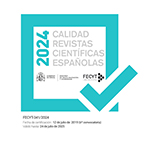The Basel Model for the analysis of Spanish también: a contrastive perspective with Italian
Abstract
The present paper aims at performing a contrastive analysis of the Spanish additive particle también and its acceptable equivalents in Italian so as to detect the most relevant levels of cross-linguistic confrontation. A functional perspective and a semasiological approach – i.e. from sign to function – are endorsed for the analysis of the lexeme. Moreover, the study implements a model for paragraph segmentation, namely the Basel Model (Ferrari et al. 2008). According to previous studies (e.g. Borreguero 2014 and De Cesare / Borreguero 2014), this pragmatic segmentation model proves useful in disclosing the textual behavior of polyfunctional markers, even from a contrastive perspective. As a case in point, the collocation of también within the Frame unit entails the activation of the connective (vs. focus adverb) function, which leads to the selection of Italian equivalents that are different from anche. Finally, special attention will be paid to a number of cases related to the referential ambiguity of también, which is prompted by its notable distributional mobility and which ought to be solved in translation in order to convey a matching set of elements in the two versions.
Downloads
Article download
License
In order to support the global exchange of knowledge, the journal Cuadernos de Filología Italiana is allowing unrestricted access to its content as from its publication in this electronic edition, and as such it is an open-access journal. The originals published in this journal are the property of the Complutense University of Madrid and any reproduction thereof in full or in part must cite the source. All content is distributed under a Creative Commons Attribution 4.0 use and distribution licence (CC BY 4.0). This circumstance must be expressly stated in these terms where necessary. You can view the summary and the complete legal text of the licence.










